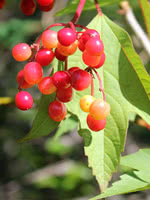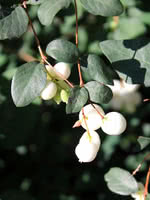Mon-Fri 9am - 5pm Mountain time
Highbush Cranberry vs Western Snowberry
Viburnum opulus var. americanum (trilobum)
Symphoricarpos occidentalis
NOT AVAILABLE THIS SEASON - MIGHT RETURN
Highbush Cranberry produces attractive white flowers in late June and bears edible fruit that matures to a bright red colour in the late summer.
This shrub, native to much of Canada, is fast growing, and its fruit can be eaten raw or cooked into a sauce.
Like the Common Snowberry, the Western Snowberry is a small shrub with pink flowers useful for feeding livestock and preventing erosion. Unlike the common species, however, the Western Snowberry is much more suited to wet conditions, capable of persevering through poor soil drainage and occasional flooding.
After the Snowberry's flowers have bloomed, it produces berries which often last on the plant through winter. These berries are toxic to humans, but livestock and local wildlife love them! Those hoping to attract wildlife to their property can plant Snowberry and expect to see animals foraging on it much later in the year than other plants.
Highbush Cranberry Quick Facts
Western Snowberry Quick Facts
Toxicity: berries are toxic to humans
In row spacing: 0.6 m (2.0 ft)

